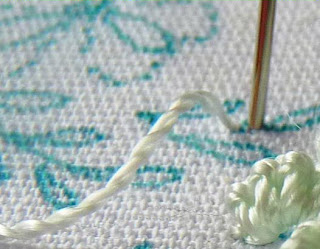It won't be long now. I'll soon release several new Millefiori Brazilian dimensional embroidery designs and also plan to teach some new dimensional stitch techniques at the BDEIG Seminar in Portland, Oregon this coming June.
In this picture Mom and Dad owl are listening to Wind Chimes (the name of the design) and their lilting melody in the soft spring breezes. Well, except for one of the youngsters ...
In this picture Mom and Dad owl are listening to Wind Chimes (the name of the design) and their lilting melody in the soft spring breezes. Well, except for one of the youngsters ...
...the little redhead owl, who is busy listening to her own smart phone. I had a lot of fun planning this design. I used several familiar stitches and just moved them around, combining them in new ways for different kinds of flowers. Here's one of the 'chimes' where Boucle passes through the fabric only one time [oops. OK, make that TWO times] - at the beginning and at the end:
There are more surprises in this surprisingly easy design that I made into a little art quilt. Look for Millefiori design #8004 "Wind Chimes".
Rosalie

























